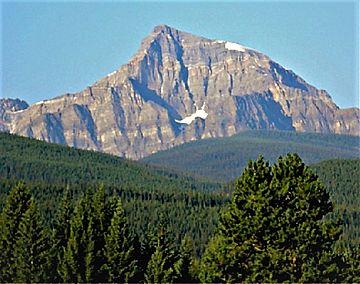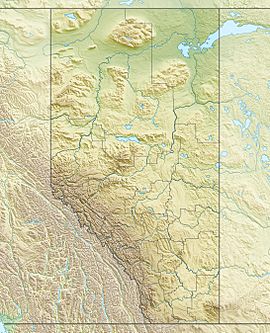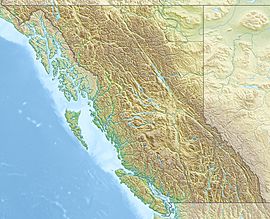Storm Mountain (Canada) facts for kids
Quick facts for kids Storm Mountain |
|
|---|---|

Storm Mountain seen from Highway 1, the Trans-Canada Highway
|
|
| Highest point | |
| Elevation | 3,158 m (10,361 ft) |
| Prominence | 408 m (1,339 ft) |
| Parent peak | Mount Ball (3294 m) |
| Listing | Mountains of Alberta Mountains of British Columbia |
| Geography | |
| Country | Canada |
| Parent range | Ball Range Canadian Rockies |
| Topo map | NTS 82O/04 |
| Geology | |
| Age of rock | Cambrian |
| Type of rock | Sedimentary rock |
| Climbing | |
| First ascent | 1889 W.S. Drewry, A St. Cyr, T.E. Wilson |
| Easiest route | Scramble |
Storm Mountain is a tall peak in the Canadian Rockies. It stands 3,158 meters (about 10,361 feet) high. This mountain sits right on the Continental Divide. This means it's on the border between Alberta and British Columbia in Canada.
The mountain is also part of two big national parks. It's on the edge of Kootenay National Park and Banff National Park. Storm Mountain is a large peak in the northern part of the Ball Range. It is across from Castle Mountain in the Bow Valley. Nearby are Vermilion Pass to the northwest and Stanley Peak to the southwest. The closest higher mountain is Mount Ball, about 5.7 kilometers (3.5 miles) to the south.
Contents
Mountain History
How Storm Mountain Got Its Name
In 1884, a man named George Mercer Dawson gave Storm Mountain its name. He was camping near the mountain. It was often covered by storms while he was there. So, he decided to call it Storm Mountain.
First Climbers and Official Name
The first people to climb to the top of Storm Mountain were W.S. Drewry and A St. Cyr. This happened in 1889. They had a guide named Tom Wilson with them. The mountain's name became official in 1924. This was decided by the Geographical Names Board of Canada.
Mountain Geology
What Storm Mountain is Made Of
Storm Mountain is made of sedimentary rock. This type of rock forms from layers of sand, mud, and tiny bits of plants and animals. These layers were laid down a very long time ago. This happened during the Precambrian to Jurassic periods.
How the Mountain Formed
The sedimentary rock formed in shallow seas. Over millions of years, these rocks were pushed up. This happened during an event called the Laramide orogeny. This process pushed the older rock layers east. They ended up on top of younger rock layers.
Mountain Climate
Weather at Storm Mountain
Storm Mountain has a subarctic climate. This means it has cold, snowy winters. The summers are usually mild. Temperatures can drop very low, sometimes below −20 °C (–4 °F). With the wind, it can feel even colder, below −30 °C (–22 °F).
Best Time to Visit
The best time to climb Storm Mountain is from July through September. The weather is usually better during these months. Water from the mountain melts and flows in two directions. Some water drains west into the Vermilion River. Other water flows east into the Bow River.
The "Other" Storm Mountain
It's a bit confusing, but George Mercer Dawson named another peak "Storm Mountain" too. This other mountain is about 100 kilometers (62 miles) away. It is located in Kananaskis Provincial Park to the southeast. It is quite unusual for two mountains so close to each other to have the same name. Especially when the same person named both of them!



